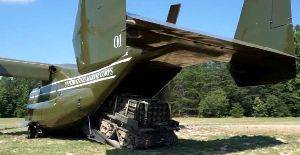Articles >>
Stratom XR-P Demonstrates Autonomous Loading, Unloading From MV-22
Category: Robots

Colorado-based Stratom’s new eXpeditionary Robotic-Platform, or XR-P, was recently demonstrated by the U.S. Marine Corps, which used it to autonomously load and unload supplies from an MV-22 Osprey vertical takeoff and landing aircraft. Stratom has been working on the XR-P for about three years, in response to a Small Business Innovation Research proposal for resupply systems to work with the MV-22. The main benefit of the XR-P is that it can autonomously drive in and out of the MV-22 while carrying more than 2,400 pounds of supplies, greatly reducing the manpower needed to unload supplies or ammunition from the aircraft. The XR-P can also tow up to 1,800 pounds with a full load. Marine Corps officials “were amazed at how quickly it could be loaded and unloaded in and out of the aircraft,” Stratom CEO Mark Gordon tells AUVSI. By cutting resupply mission time, the XR-P also increases the amount of resupply sorties and cuts down on aircraft fuel consumption, according to the company. The XR-P features tracks, which allows better weight distribution for cargo carrying but also allows the vehicle to traverse a variety of rough terrain. It also features various control modes, including teleoperation, waypoint navigation, obstacle avoidance and “follow-me mode,” where it can follow an individual Marine. The key to the system is the autonomous loading and unloading, Gordon says. “This capability has never been demonstrated before,” he says. The company plans to continue internal development of the XR-P, which could be used for a variety of purposes, from resupply to humanitarian relief to casualty evacuation. |
Stratom |
QinetiQ and Pratt Miller Deliver First Robotic Combat Vehicle - Light to U.S. Army
02.02.2021
Kungas Unmanned Ground Vehicle Tested in Russia
11.12.2019
FLIR Wins U.S. Army Heavyweight Robot Contract Worth Up to $109M
06.12.2019
General Dynamics Robotic Systems - GDRS
Automotive Robotic Industry - ARI
Discuss
